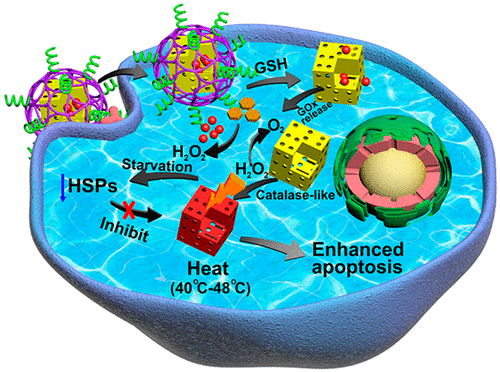Our official English website, www.x-mol.net, welcomes your
feedback! (Note: you will need to create a separate account there.)
Engineering of a Nanosized Biocatalyst for Combined Tumor Starvation and Low-Temperature Photothermal Therapy
ACS Nano ( IF 15.8 ) Pub Date : 2018-03-06 00:00:00 , DOI: 10.1021/acsnano.8b00309 Jun Zhou , Menghuan Li , Yanhua Hou 1 , Zhong Luo , Qiufang Chen , Hexu Cao , Runlan Huo , Chencheng Xue , Linawati Sutrisno , Lan Hao 2 , Yang Cao 2 , Haitao Ran 2 , Lu Lu , Ke Li , Kaiyong Cai
ACS Nano ( IF 15.8 ) Pub Date : 2018-03-06 00:00:00 , DOI: 10.1021/acsnano.8b00309 Jun Zhou , Menghuan Li , Yanhua Hou 1 , Zhong Luo , Qiufang Chen , Hexu Cao , Runlan Huo , Chencheng Xue , Linawati Sutrisno , Lan Hao 2 , Yang Cao 2 , Haitao Ran 2 , Lu Lu , Ke Li , Kaiyong Cai
Affiliation

|
Tumor hypoxia is one of the major challenges for the treatment of tumors, as it may negatively affect the efficacy of various anticancer modalities. In this study, a tumor-targeted redox-responsive composite biocatalyst is designed and fabricated, which may combine tumor starvation therapy and low-temperature photothermal therapy for the treatment of oxygen-deprived tumors. The nanosystem was prepared by loading porous hollow Prussian Blue nanoparticles (PHPBNs) with glucose oxidase (GOx) and then coating their surface with hyaluronic acid (HA) via redox-cleavable linkage, therefore allowing the nanocarrier to bind specifically with CD44-overexpressing tumor cells while also exerting control over the cargo release profile. The nanocarriers are designed to enhance the efficacy of the hypoxia-suppressed GOx-mediated starvation therapy by catalyzing the decomposition of intratumoral hydroperoxide into oxygen with PHPBNs, and the enhanced glucose depletion by the two complementary biocatalysts may consequently suppress the expression of heat shock proteins (HSPs) after photothermal treatment to reduce their resistance to the PHPBN-mediated low-temperature photothermal therapies.
中文翻译:

用于肿瘤饥饿和低温光热疗法相结合的纳米生物催化剂的工程设计
肿瘤缺氧是治疗肿瘤的主要挑战之一,因为它可能会对各种抗癌方式的疗效产生负面影响。在这项研究中,设计和制造了一种靶向肿瘤的氧化还原反应性复合生物催化剂,它可以结合肿瘤饥饿疗法和低温光热疗法来治疗缺氧的肿瘤。通过将葡萄糖氧化酶(GOx)填充到多孔空心普鲁士蓝纳米颗粒(PHPBNs)中,然后通过氧化还原可裂解的连接将透明质酸(HA)覆盖在表面上,从而使纳米载体与过表达CD44的肿瘤细胞特异性结合,从而制备出纳米系统。同时还可以控制货物的释放状况。
更新日期:2018-03-06
中文翻译:

用于肿瘤饥饿和低温光热疗法相结合的纳米生物催化剂的工程设计
肿瘤缺氧是治疗肿瘤的主要挑战之一,因为它可能会对各种抗癌方式的疗效产生负面影响。在这项研究中,设计和制造了一种靶向肿瘤的氧化还原反应性复合生物催化剂,它可以结合肿瘤饥饿疗法和低温光热疗法来治疗缺氧的肿瘤。通过将葡萄糖氧化酶(GOx)填充到多孔空心普鲁士蓝纳米颗粒(PHPBNs)中,然后通过氧化还原可裂解的连接将透明质酸(HA)覆盖在表面上,从而使纳米载体与过表达CD44的肿瘤细胞特异性结合,从而制备出纳米系统。同时还可以控制货物的释放状况。











































 京公网安备 11010802027423号
京公网安备 11010802027423号